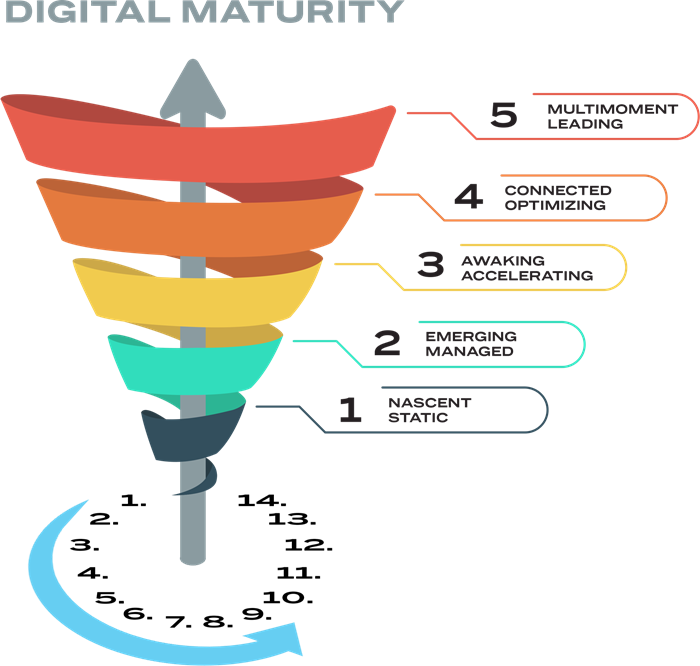Do you have a concise plan to gain wallet share?
Have you defined how to increase sales from your site?
Is your digital strategy designed for wholesale distribution?
The Layer One B2B Distributor eCommerce Success Guide explains 14 Focus Points that are your path to accomplishing these goals and more. The guide presents a circular, cumulative approach that allows you to start where you're at, and begin the "spiral" process of digital growth, with each improvement adding on to the last.

Please find summaries of the 14 Focus Points from the Success Guide below along with mini previews for the first two points.

1. Site Stability / Performance
An e-commerce site must be fast, available, and error-free before adding enhancements or features to drive conversions.
Site stability refers to the ability of your website to remain operational and accessible to users at all times. A stable site ensures that your customers don't face any technical issues while browsing or making purchases on your website. Site downtime can be a significant setback for any business, as it can lead to lost sales, decreased customer satisfaction, and damage to your brand reputation.
In B2B eCommerce, where sales cycles are longer, and the purchasing decision involves multiple stakeholders, site stability becomes even more crucial. A stable website ensures that your customers can access the information they need when they need it, facilitating the decision-making process. Moreover, a stable site enhances the credibility of your business, which is essential in building trust with your customers.
Suggestions: Work with your technology partner to improve your site. Monitor KPIs like downtime per month (in minutes), page transition speed (in seconds), search speed(in seconds), etc. Consider asking an outside vendor (like us) for an audit of some of these over time. Finally, contacting the platform author for some reasonable values of the above metrics can provide some instant clarity.
Tools: There are a TON of tools to monitor site stability and performance. For starters, tools like Microsoft Azure’s Application Insights can provide a wealth of information on site stability, and Google PageSpeed Insights can give you a performance baseline.
2. Iterative Thinking
Change behavior to deliver small, short-term wins that rapidly improve the site to increase functionality and customer satisfaction. This allows constant alignment between reality and large strategic initiatives.
Iterative thinking is a problem-solving approach that involves breaking down complex problems into smaller, more manageable parts. It involves testing and refining strategies through a cycle of feedback and improvement until the desired outcome is achieved. In simple terms, iterative thinking involves the four steps of plan, do, check and act in regular repetition.
Within digital marketing and eCommerce efforts, iterative thinking is particularly relevant, as businesses are constantly striving to optimize their online presence, attract new customers and increase sales. By using an iterative approach, businesses can test and refine their marketing strategies, website design, content, product data quality, search and user experience until they achieve the desired results.
Suggestions: Start small. Pick one of your top three issues and ask yourself “Is there something very small that I can do in a day or two to improve the situation?” Then do it. Follow up with some observations on if the change had the intended effect. Yes? Great! No? Try something else of an equllally small size. This is the basis of iterative thinking.
Tools: Making a ton of small changes can be a management nightmare. Consider using a “task board” like Microsoft’s Teams Tasks or Atlassian Trello. This will make the work visible and reduce some of the stress caused by trying to keep everything in your head.
3. Product Data Quality
Beyond completeness and accuracy, provide the right data in the best way so customers buy what they need and come back again.
4. Empower Search
Know the various ways customers look for a product and then ensure the search engine is configured in a way that returns relevant results.
5. User Experience
From entering a site, the fewer, more obvious clicks it takes to buy a product the better. Efficient and quick ordering is a top priority for B2B buyers.
6. Growth KPIs
Measuring the right things is critical to addressing issues or discovering opportunities. This goes beyond the site to include OSRs, contractors, and other metrics.
7. E-comm Onboarding
Once someone has decided to become a customer, the process to obtain an account to begin buying must be quick, clean, and establish their pricing or other customizations.
8. Customer facing rep strategy
Having a synergistic digital strategy plan that encourages site adoption from reps and their accounts is critical to growing e-commerce. This includes incentive plans, training, and sales enablement tools.
9. Data Jobs automation/ Integrations
Ensuring that product data, orders, and customer data automatically flow within an e-commerce site and to other systems increases efficiency and reduces costs.
10. Mobile Approach & App
People now expect to be able to shop and buy from B2B the same way they buy from B2C. This means not providing a great mobile experience results in lost sales.
11. Promotions
Leverage all the various and complex promotional opportunities to incentivize customers to purchase online.
12. Cross-sell / Up-sell
To stimulate additional revenue, a site must be empowered to present related and bundled products along with more expensive or premium substitutes.
13. Tech-based communications channels
Customers want and expect to talk to live reps through chat, text, or social platforms rather than waiting at the counter or on hold.
14. AI & Personalization
Once a site has been optimized and maximized, AI or advanced personalization will create a better experience for new customers and build loyalty.
